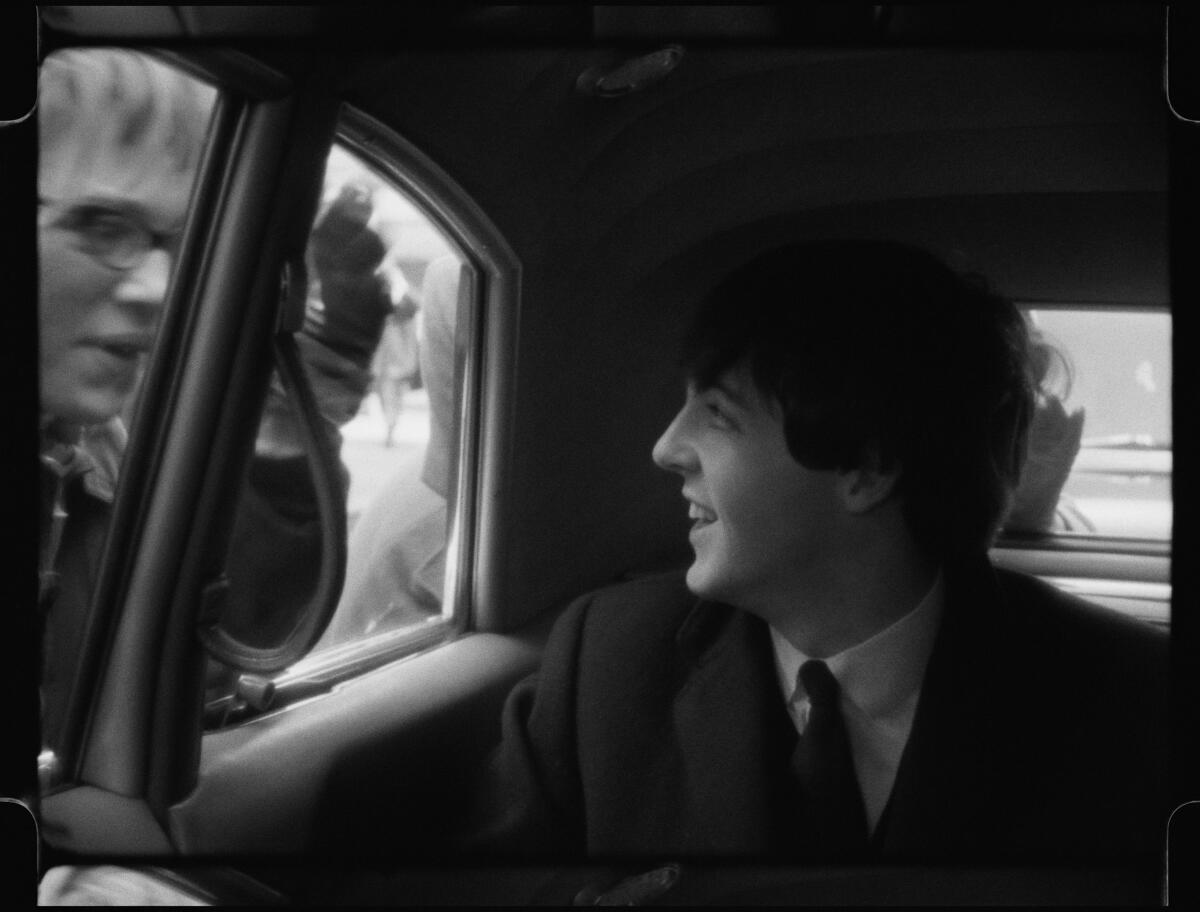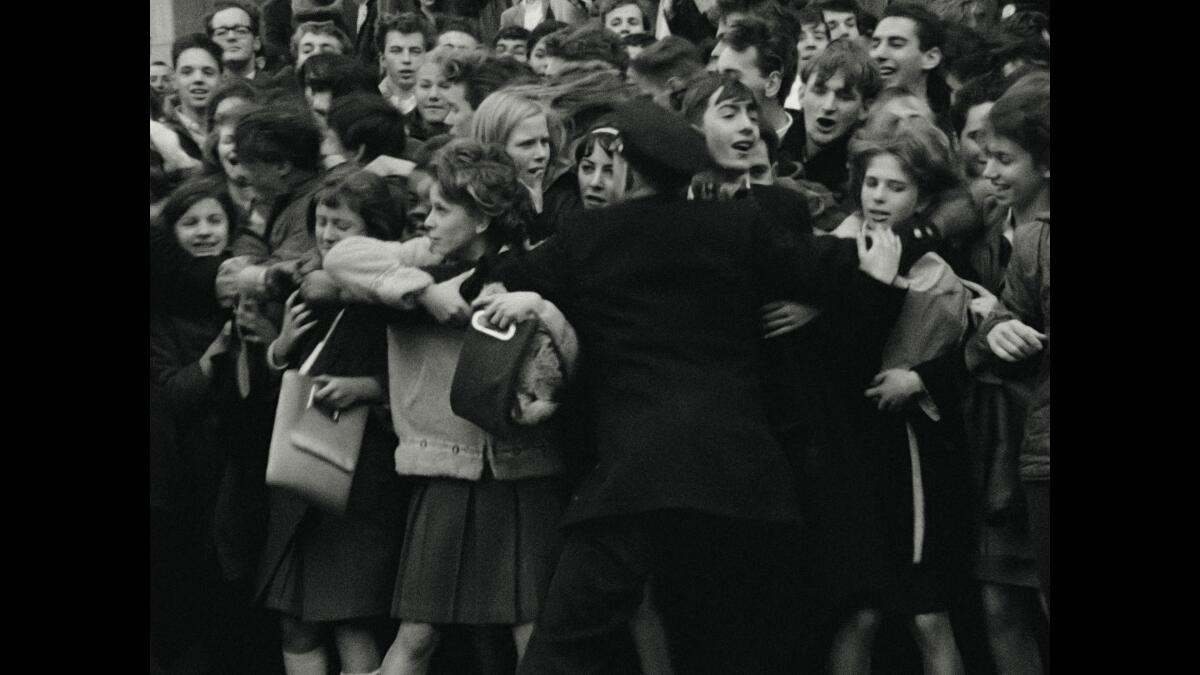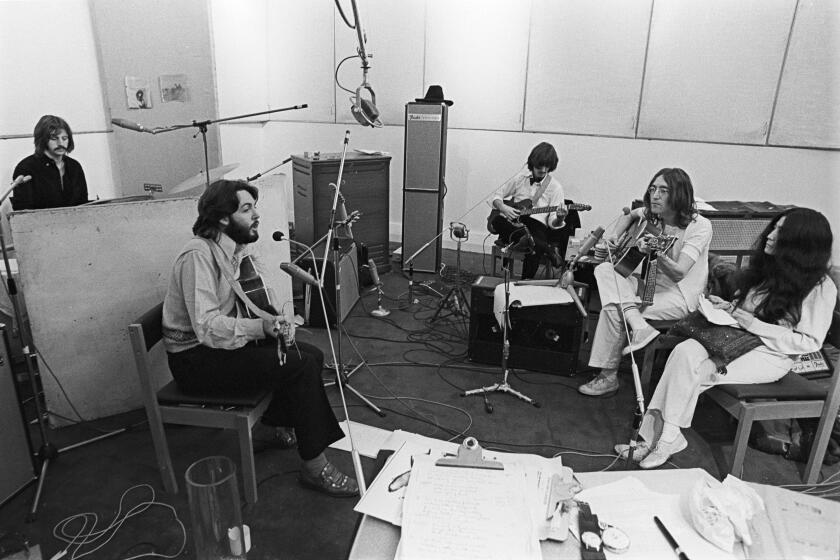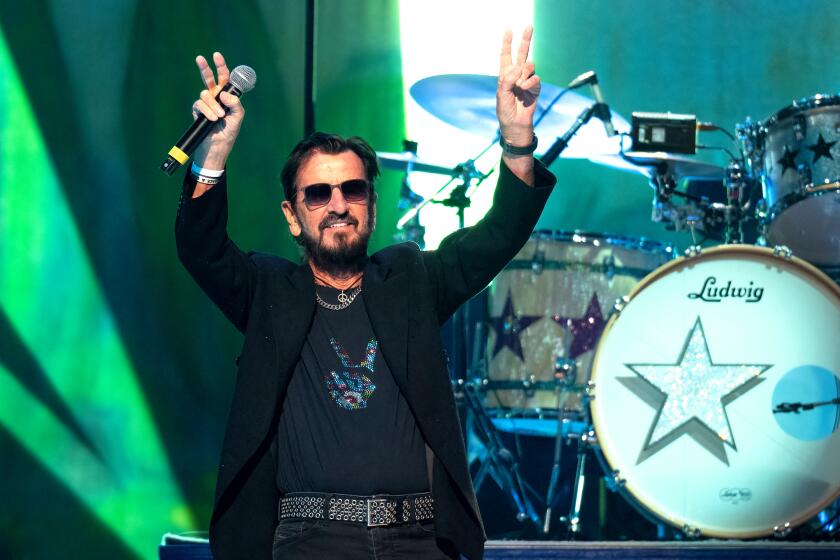Review: ‘Beatles ’64’ shows an unguarded band stepping into America’s limelight

- Share via
It’s often claimed, I’m not sure on what authority, that the Beatles’ arrival in America, three months after the assassination of President Kennedy, in some unquantifiable way lifted the spirits of a depressed nation, allowing it to move forward into the light. Perhaps reliving it in 2024 will bring similar relief, though of course, some will just long for the past.
It’s a thought repeated by Paul McCartney himself in a delightful new-old documentary “Beatles ’64,” premiering Friday on Disney+, in what, after “The Beatles Anthology” in 1995 and “Get Back” in 2019, might be seen as an infrequent Thanksgiving tradition. The film, produced by Martin Scorsese and directed by David Tedeschi, is the latest repurposing of footage shot by Albert and David Maysles, when the band crossed the pond to appear on “The Ed Sullivan Show” in February 1964.
The Maysleses’ footage was originally used for the BBC documentary “What’s Happening! The Beatles in the U.S.A.,” and formed the substance of the 1991 “The Beatles: The First U.S. Visit.” (Bits and pieces have appeared in various Beatles docs over the years; it is foundational stuff.) But there is more of it here, interspersed with new interviews with McCartney, Ringo Starr and fans and friends who participated in the moment, along with archival interviews with George Harrison and John Lennon and some needless social context from Marshall McLuhan and Betty Friedan. Happily absent are later-generation pop stars testifying to the band’s genius, or worse, singing their own versions of Beatles songs. Not even the Beatles testify to their own genius.
“You must be kidding with that question,” says McCartney, when a reporter asks about their place in “Western culture.” “It’s not culture, it’s a good laugh.”

The action unrolls mostly in and around New York’s Plaza Hotel; in Washington, D.C., where they performed their first American concert; and on trains traveling back and forth. Other stops and dates on the trip — a second Sullivan broadcast from Miami Beach, a concert at Carnegie Hall — are filled in with photos and interviews.
The Maysleses, who five years later would direct what is largely considered the greatest of all rock ’n’ roll documentaries, “Gimme Shelter,” were founding members of the fly-on-the-wall “direct cinema” movement, the domestic cousin of ciinéma vérité. Shot in 16mm black and white, the footage has a paradoxical immediacy lost to a world in which, by one count, 14 billion color images are posted to social media every day. Coincidentally or not, the style and even scenes in the Maysles film are echoed in “A Hard Day’s Night,” which began filming a month later. (“This is what our movie will be like,” says John, looking out at the passing scenery. “The train days.”)
Nowadays rock groups are the producers of their own massaged, glossy documentaries — Bruce Springsteen has a “written by” credit on this year’s “Road Diary” — where even the revelations are carefully chosen and measured out. Yet once it was the custom to let cameras in to catch what they might. Out at the Peppermint Lounge, presaging a similar scene in “A Hard Day’s Night,” McCartney and Lennon and a dancing Starr are clearly, happily inebriated; they don’t have their guard up yet, or handlers to get between them and the camera. (The Beatles organization was surprisingly small; you could fit the whole operation in a van.)
Peter Jackson’s nearly eight-hour Beatles doc both refutes the canard of Yoko as band-wrecker and reminds us of what was lost when Paul and John went separate ways.
In their Plaza suite, they smoke cigarettes, read newspapers, watch themselves on TV and mess with the film crew, forcing them through the fourth wall: “There’s a woman there, you see,” says McCartney, “with a little microphone, see, and she daren’t talk.” They listen to Pepsi-branded transistor radios, fence with disc jockey Murray the K, who insinuates himself into their inner sanctum. (“I’ve never quite understood how he did that,” says George, looking back.) In a train car packed with press, they clown — Harrison in a porter’s uniform, carrying a tray of cans of 7-Up (“It’s me!” he tells the camera, coming in close and doffing his cap), Starr with a dozen cameras and camera bags slung around his neck, Harrison lying in an overhead luggage rack, slating the film. (McCartney sits it out: “I’m not in a laughing mood, even.”)
Meanwhile, fans, mostly teenage girls (some carrying their schoolbooks), crowd the barriers at the Plaza Hotel, penetrate its halls, press their faces to the windows of the limousine carrying the band to the Sullivan show, and chase it down the street. In their strong New Yawk accents, of a kind that may have vanished from the Earth, they attempt to explain their love for the Beatles, and particular Beatles.

They were exotic — not merely English, but thanks to the influence of their arty German friends Astrid Kirchherr and Klaus Voormann, they were continental. With their combed-down “long” hair and Cuban heels, they look like the future. (And had more than a little to do with what the future would look like.) At the same time, they were working-class kids from a city still recovering from World War II, with a deep love for Black American pop music, which they reintroduced to white America. (They were curators as well as creators.) Smokey Robinson, who had met them in England and whose “You’ve Really Got a Hold On Me” they covered, calls them the “first white group that I had ever heard in my life … say, ‘Yeah, we grew up listening to Black music.’” The late Ronnie Spector, another friend, recalls taking the band for barbecue in Harlem, where they basked in the luxury of being ignored.
Ahead of a Sept. 8 show at L.A.’s Greek Theatre, the 84-year-old Beatles legend remembers how he put the All-Starr Band together.
That would only become harder. I daresay we know more about the Beatles than any other pop band in history — their music, their less than private private lives, their fab gear, where they were and what they were doing nearly every day of their eventful career. (Mark Lewisohn‘s excellent, engaging “Tune In,” the first of a projected three-volume group biography, which doesn’t even get to 1963, runs nearly a thousand pages; it’s also available as a 1,728-page extended version.) Imagine if we had that much on, say, William Shakespeare, not just a couple of probable, probably posthumous portraits, but photos, video, interviews and documents numbering in the hundreds of thousands — not to mention books by everyone who knew him even slightly. It would kill the Who Really Wrote Shakespeare business, but there’d be so much more to parse. (Incidentally, the Beatles played Shakespeare, the “Pyramus and Thisbe” section of “A Midsummer Night’s Dream,” in their 1964 TV special “Around the Beatles.”)
They spring eternal: “Now and Then,” the “last” Beatles song, which digitally combines all four members, is currently nominated for two Grammys, 54 years after the band disbanded and 44 after Lennon, who wrote and sings it, was shot. They will be listened to and discussed and studied for years to come, long after I’m around to know whether my prediction is right. Beatlemania may be done, but somewhere a child is singing the chorus to “Yellow Submarine.”









